Turkmenistan
| V・T・E Türkmenistan |
| latitude: 39.08, longitude: 59.51 |
| Browse map of Turkmenistan 39°04′48.00″ N, 59°30′36.00″ E |
| Edit map |
|
External links:
|
| Use this template for your locality |
Turkmenistan is a country in Central Asia at latitude 39°04′48.00″ North, longitude 59°30′36.00″ East.
Notes on Turkmenistan
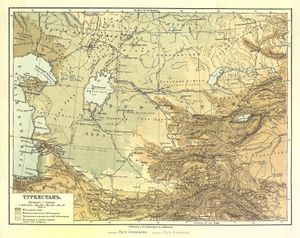

Note on Imagery
Since Turkmenistan is undergoing constant redevelopment of urban areas and expansion of its national road network, choice of imagery is important. With regards to satellite imagery, in general OSM's Bing imagery is to be avoided if newer alternatives are available, particularly when mapping Ashgabat.
Ground-level imagery from Mapillary and to a lesser extent KartaView is available for several major routes between cities and for some downtown areas of major cities.
Note on Topography
Major topographic features include deserts and semi-deserts, which cover over 80 percent of Turkmenistan's territory; the Kopetdag and Koytendag (Kugitangtau) mountain ranges, which are spurs of the Pamir-Alay range; and the Greater and Lesser Balhan ranges, all of which together cover roughly 8 percent of Turkmenistan. The remaining approximately 12 percent of Turkmenistan's land area consists largely of high plains, foothills, oases, and river valleys that slope downward east to west in the direction of the Caspian Sea. Four major rivers serve Turkmenistan: the Amu Darya, Tejen, Murghab, and Etrek. About three thousand rivers exist in Turkmenistan but 95 percent of them are shorter than 10 kilometers in length, and all but 40 of them are seasonal. The so-called Garagum River is not a true river, but rather an artificial canal, the Karakum Canal, dug in the 1960s by Soviet authorities to supply water to Ashgabat and southwestern Turkmenistan. It runs dry in the general area of Bereket. The western land border of Turkmenistan is the shore of the Caspian Sea, a landlocked body of water. Only one river in Turkmenistan, the Etrek, normally flows into the Caspian.[1] In recent years, however, the Etrek runs dry short of the Caspian due to diversion of water in Iran.
The Karakum (Garagum) Desert, the 13th largest desert in the world[2], covers 350,000 square kilometers and lies to the south of the Turanian Depression. The Karakum Desert covers 72 percent of Turkmenistan's area.
The Kopetdag Mountains, a northern spur of the Turkmen-Khorasan mountains, extend in Turkmenistan from Sarahs in the east to Bereket in the west, a distance of some 500 kilometers, and consist of four ridges. The highest point in the Kopetdag in Turkmenistan is Shahshah at 2,912 meters. The Lesser and Greater Balhan ranges lie to the northwest of the Kopetdag; the Lesser Balhan measures 30 kilometers long by 12 kilometers wide, with a maximum elevation of 774 meters above mean sea level. The Greater Balhan range lies northeast of the Lesser, and is 70 kilometers long by 50 kilometers wide, with a maximum elevation of 1,880 meters (Mount Arlan). The Koytendag Mountains are a spur of the Hissar (Gissar) Range, itself a branch of the Pamir-Alay system, lying in the far southeast of Turkmenistan. In Turkmenistan, these mountains extend 100 kilometers in length and 25 kilometers in width. The highest peak in the Turkmen Koytendag is Ayrybaba Peak at 3,139 meters.[1]
Turkmen Terms for Natural Features
The following terms are frequently encountered in the names of natural features.
ada island
aýlag bay, gulf
dag mountain
deňiz ocean, sea
depe hill
derýa river
howdan reservoir
howuz pond, reservoir
köl lake
Ironically the Turkmen word for "desert" (çöl) is virtually never encountered. The deserts, Karakum (Garagum, "black sand") and Kyzylkum (Gyzylgum, "red sand"), are simply referred to by their proper names, perhaps because they are the dominant landscape features in Turkmenistan.
Administrative Subdivisions
List of Cities, Provinces, Districts, and Municipalities
See separate article Districts in Turkmenistan
Please see the separate Districts in Turkmenistan article, which is based on an authoritative list of administrative subdivisions of Turkmenistan as of 5 January 2018, augmented by corrections as published in official documents. The original list as published did not appear to include all hamlets and farming communities (farmer associations or daýhan birleşigi) and omitted a few towns attested in other documents; this list incorporates all known sources. Please also see the wiki articles on each of the provinces for lists of the districts (etraplar) in each province (welaýat). Links are provided below in the See Also section.
See as well the Wikipedia article Districts of Turkmenistan, which was brought up to date in April 2021.
N.B. In Turkmenistan names of cities, towns, and villages are often reused, hence the existence of both the city of Turkmenbashy and the town of Turkmenbashy in Balkan province, for example. In addition, villages sharing the same name can be found in multiple provinces. Care is advised when identifying municipalities to avoid mixing them up.
Geographic Name Changes
See separate article Turkmenistan Geoname Changes
Since Turkmenistan achieved independence in 1991, many districts, cities, towns, and villages have been renamed, in some cases multiple times. No complete list of name changes appears to exist, though a partial list of cities (it omits recent restoration of former names, such as Kerki and Büzmeýin) can be found here. A somewhat more comprehensive list of cities and towns with their previous names is in Turkmenistan Geoname Changes. Mappers are encouraged to use current names of municipalities as shown on signage (please refer to ground-level imagery) and to add historical former names using the name:<yyyy-yyyy> tag, e.g., name:2002-2018=Abadan for the former town, now neighborhood of Ashgabat, currently (re)named Büzmeýin.[3] Caution and thorough review are recommended before mappers new to Turkmenistan engage in "correction" of geographic names--make sure that the reference you are using is current!
Administrative Structure
Turkmenistan is subdivided by a complex and to many observers confusing hierarchy of administrative units and subunits. Please note that the information in the table below does not correspond necessarily to OSM categories; it is, rather, a presentation of Turkmen statute and regulation, in a manner intended to be both comprehensible to cartographers and an accurate reflection of Turkmenistan's mode of organizing "administrative-territorial subunits".
Turkmen law is quite strict in in its definition of what constitute cities, towns, and villages. Cities and towns must possess certain levels of amenities (hospitals, schools, clinics) in descending order, with the lowest level of amenities in small villages. There are also population requirements, so that a rise or fall in population can result in reclassification of a municipality from one category to another.
Cities equivalent to a district
Such cities must have a population of more than 30,000; such cities include all provincial capitals; otherwise such a city is one of the economic, cultural and administrative centers in the province. As of 2023 there are seven such cities with district-status.
Cities subordinate to a district
Such cities are subordinated to the district (etrap) government and are administered jointly; have a population of more than 8,000; possess industrial enterprises, construction and transport organizations, utilities, municipally owned housing stock, socio-cultural institutions, trade and social services; often are administrative centers of their districts.
Towns
Towns have a population of more than 2,000, and feature well-planned and landscaped territory, industrial enterprises, construction and transport organizations, railway stations, water works, hospitals and other inpatient facilities.[4]
| Turkmenistan: Political and Administrative Subdivisions | ||
|---|---|---|
| Administrative Level | Notes | Examples |
| A | National Government | |
| B | Province (welaýat). Headed by presidentially appointed governor (häkim). | Balkan Province, Ahal Province, Dashoguz Province, Mary Province, Lebap Province |
| C | City (şäher) with the status of a province (welaýat). Law stipulates population over 500,000 and status as "economic, political and cultural center of Turkmenistan." Headed by presidentially appointed mayor (häkim). | Ashgabat |
| D | Districts (etrap, район) of provinces, or boroughs (etrap, район) of Ashgabat, Arkadag, or Turkmenbashy. Subordinated to provincial or Ashgabat/Arkadag/Turkmenbashy city government; headed by a presidentially appointed häkim. | Berkararlyk etraby of Ashgabat, Ak Bugdaý etraby of Ahal Province, Awaza etraby of Turkmenbashy, Ýolöten etraby of Mary Province |
| E | Cities (şäher, город) with status of such a district (etrap, район). Law stipulates such cities must have population over 30,000 and be the administrative center of a province (welaýatyň merkezi); headed by a presidentially appointed häkim. In practice, not only the provincial centers enjoy this status, however; as of November 9, 2022, 7 cities in Turkmenistan enjoy district status and feature a häkimlik. | Turkmenabat, Mary, Balkanabat, Dashoguz |
| F | Cities (şäher, город) "in a district" (etrap, район). Law stipulates a settlement with population over 8,000 and an industrial plant, construction and transport organizations, public utilities, public housing, network of social-cultural organizations, and trading organizations. "Cities in a district" are subordinate to the district in which they are located. | Magdanly in Lebap Province, Kaka in Ahal Province, Garabogaz in Balkan Province |
| G | Districts of cities other than of Ashgabat, Arkadag, or Turkmenbashy (etrapça, район). No specific legal status; these are administrative subunits of the municipality. In some cities and towns they are called kwartal (quarter) or ýaşaýyş jaý toplumy (residential housing complex). | Bahar District (Bahar etrapçasy) in Turkmenabat |
| H | Towns (şäherçe, посёлок). Population over 2,000. Headed by a geňeş chaired by an arçyn. | Arçman şäherçesi in Ahal welaýaty |
| I | Ashgabat microdistricts (etrap, микрорайон). No specific legal status; administrative subunit of an Ashgabat borough. No separate government structure. | 11 Etrap in Ashgabat, Parahat 3 in Ashgabat |
| J | "Rural council" municipality (geňeşlik, генгешлик) (In Soviet times called "rural soviet" сельсовет). One or more villages under a common administration consisting of a geňeş (council) and an arçyn (council chair). | Bereketli in Ak Bugdaý district, comprising the villages of Bukry, Diňli, Gamyşly, Gyzyltakyr, Kükürtli, Sakarçäge, Sözenli, with administrative center in Bukry |
| K | Villages (oba, село) (in the past sometimes referred to as aul). This category also includes daýhan birleşigi, "peasant association", which refers to former collective- and state farms. Minimum population of 50 permanent residents. No separate government structure; subordinate to the "rural council" (geňeşlik). | Garaşsyzlyk obasy of Gowşutbent geňeşlik of Mary Province |
Notes on the Terms häkim and etrap
The same word, häkim, applies both to governors of the five provinces (welaýat) plus governors of their subordinate districts (etrap), and to municipal mayors. One word, etrap, applies simultaneously to districts of provinces, to the four boroughs of the city of Ashgabat (Büzmeýin, Berkararlyk, Köpetdag, and Bagtyýarlyk), two boroughs of the city of Arkadag (Gorjaw and Kärizek), a borough of the city of Turkmenbashy (Awaza), and to Ashgabat's microdistricts (called in Russian mikrorayon микрорайон, a borrowing from the Soviet period). The same name can apply to a city and a province (e.g., Mary) or to a town and a district (e.g., Ýolöten). Two boroughs of Ashgabat City share names with neighborhoods in the city that are distinct from those boroughs. They are Büzmeýin etraby, which is distinct from the neighborhood and former city of Büzmeýin, and Bagtyýarlyk etraby, which is distinct from the neighborhood of Bagtyýarlyk. To add to confusion, until 2018 Büzmeýin was called Abadan, and Bagtyýarlyk was named Ruhabat.
Note on Villages
Turkmenistan applies this administrative hierarchy of towns and rural settlements in descending order, but the order can be deceiving since a large village (population over 2,000) is considered to be in a different category due to its size. In the case of established villages (as opposed to greenfield projects that in the West would be called developments) these are often settlements founded during Soviet collectivization of the 1930s, and they remain attached to a former collective farm, now called a daýhan birleşigi (English: farmer (peasant) association). Some villages are subordinated to cities or towns. This information is available in the Districts in Turkmenistan article in this wiki.
To reduce administrative overhead, multiple villages are often subordinated to a single, common municipal structure called in Turkmen geňeşlik or oba geňeşligi, from the Turkmen word geňeş "council". Oba geňeşligi or "rural (village) council" is a direct translation of the original Soviet Russian term for such units, sel'skiy sovet (сельский совет). By statute, specifically the "Law on Council" of 2005 as amended, these councils are autonomous and are elected popularly by secret ballot. A "rural council" can govern a single village or several. The council elects an arçyn from among its members; the arçyn functions as the council chair as well as the town or village manager.[5]
Since the geňeşlik is a separate entity (object) from any of its subordinate villages or hamlets, it should be mapped as a separate node in the village designated as the seat of the geňeşlik. In the Districts in Turkmenistan article in this wiki, the seats are the first village listed under each geňeşlik and are additionally designated with an asterisk (*). If the location of the geňeş building is known, the geňeşlik node is best placed near it.
When tagging villages, due to rampant duplication of village names across Turkmenistan it is helpful to add the addr:city=* and addr:district=* tags, where the city is the geňeşlik and the district is the etrap. This information may often be drawn from the Districts in Turkmenistan article in this wiki, although this list has been demonstrated to be incomplete. Caution: Double-check which etrap each village is really in!
Administrative Subdivision Statistics
The tables below present uncopyrighted (public domain) data on Turkmenistan's geographic political subdivisions provided by the Turkmen statistical office and the Turkmen parliament. As such they should not be edited in order to force them into conformity with OSM categories or administrative levels; they are intended to inform the cartographer as an aid to proper designation and categorization, and represent the point of view of Turkmen statisticians, not geographers or cartographers. Mappers are also strongly advised to consult the list of political subdivisions at Districts in Turkmenistan, which spells out in great detail the structure of provinces, districts, and other municipalities.
| Administrative-Territorial Division of Turkmenistan as of January 1, 2020 | |||||||||
| Territory / Территория /
Çäkler |
Districts / Районы / Etraplar | Boroughs in Cities /
Районы в городах / Şäherlerdäki etraplar |
Cities / Города / Şäherler | including: / в том числе: / şol sanda | towns / посёлки / şäherçeler | councils / советы / geňeşlikler | rural populated points / сельские населённые пункты / oba ilatly ýerler | ||
| capital / столица / paýtagt | cities with district status / города с правами этрапа / etrap hukukly şäherler | cities in districts / города в этрапах / etraplardaky şäherler | |||||||
| Turkmenistan (total) | 43 | 6 | 51 | 1 | 11 | 39 | 62 | 504 | 1717 |
| of which: | |||||||||
| Ashgabat city | 0 | 4 | 1 | 1 | 0 | 0 | 0 | 0 | 0 |
| Ahal province | 7 | 0 | 8 | 0 | 1 | 7 | 10 | 89 | 235 |
| Balkan province | 6 | 2 | 10 | 0 | 5 | 5 | 13 | 33 | 112 |
| Dashoguz province | 9 | 0 | 9 | 0 | 2 | 7 | 1 | 134 | 612 |
| Lebap province | 10 | 0 | 15 | 0 | 1 | 14 | 24 | 105 | 429 |
| Mary province | 11 | 0 | 8 | 0 | 2 | 6 | 14 | 143 | 329 |
| Source: Türkmenistanyň sebitler boýunça administratiw-çäkleýin bölünişi, http://www.stat.gov.tm/tm/ba-sahypa/trkmenistany-administratiw-klein-blnii-1/ | |||||||||
Following a parliamentary decree of 9 November 2022, which renamed, consolidated, abolished, and/or created several municipalities, the following statistics emerged:
| Administrative-Territorial Division of Turkmenistan as of 9 November 2022 | |||||||||
| Territory / Территория /
Çäkler |
Districts / Районы / Etraplar | Boroughs in Cities /
Районы в городах / Şäherlerdäki etraplar |
Cities / Города / Şäherler | including: / в том числе: / şol sanda | towns / посёлки / şäherçeler | councils / советы / geňeşlikler | rural populated points / сельские населённые пункты / oba ilatly ýerler | ||
| capital / столица / paýtagt | cities with district status / города с правами этрапа / etrap hukukly şäherler | cities in districts / города в этрапах / etraplardaky şäherler | |||||||
| Turkmenistan (total) | 37 | 5[6] | 48 | 1 | 6 | 42 | 68 | 469 | 1690 |
| of which: | |||||||||
| Ashgabat city | 0 | 4 | 1 | 1 | 0 | 0 | 0 | 0 | 0 |
| Ahal province | 7 | 0[7] | 8 | 0 | 0 | 8 | 9 | 82 | 231 |
| Balkan province | 6 | 1 | 8 | 0 | 2 | 6 | 14 | 30 | 114 |
| Dashoguz province | 7 | 0 | 9 | 0 | 1 | 8 | 7 | 126 | 594 |
| Lebap province | 8 | 0 | 15 | 0 | 1 | 14 | 24 | 97 | 430 |
| Mary province | 9 | 0 | 8 | 0 | 2 | 6 | 14 | 134 | 321 |
| Sources: Рассмотрены вопросы совершенствования административно-территориального устройства велаятов 22 October 2022, Постановление Меджлиса Милли Генгеша Туркменистана 10 November 2022, Türkmenistanyň Milli Geňeşiniň Mejlisiniň Karary 10 November 2022 | |||||||||
Proposed admin_level=* Values for Turkmenistan
Please see Turkmenistan: Proposed Administrative Levels
Suggested Place Tags for Administrative Subdivisions
- welaýat
place=province - şäher (for "C", "E", and "F" administrative level cities)
place=city - etrap (if one of the five "D" level boroughs or "big etraps" uly etraplar of Arkadag, Ashgabat, or Turkmenbashy cities)
place=suburb - şäherçe
place=town - etrap (if a district of a province or a microdistrict kiçi etrap in a city) or etrapça
place=district - kwartal
place=quarter - geňeşlik
place=village - oba (if alone and governed by its own geňeşlik)
place=village - oba (if part of a larger geňeşlik consisting of multiple communities)
place=village - ýaşaýyş toplumy (literally, "residential complex", i.e., what in the West is called a "development")
place=neighbourhood - oba ilatly punkt (literally, "rural populated point")
place=hamlet - seasonal dwelling of pastoralists, etc.
place=isolated_dwelling
The practice of identifying former villages and towns annexed by the city of Ashgabat since 2010 has been to use place=neighbourhood (e.g., the former town of Büzmeýin or former village of Bagyr). These former towns and villages are subordinated to the respective boroughs of the city of Ashgabat and enjoy no autonomy in governance or budgeting.
General Naming Conventions
See also Turkmenistan Geoname Changes
Turkmen is the official language of Turkmenistan. Russian is spoken by an estimated 18 percent of the population, but with rare exceptions is only found on legacy signage. Dual Turkmen- and English-language signage can be encountered on some official buildings.
The preferred spelling is what is seen on signage, in accordance with OSM guidelines. If, however, a legacy sign is in Cyrillic script (increasingly rare but still encountered), one must be sure to spell the name in accordance with modern Turkmen orthographic rules using the modern Turkmen latinized alphabet.
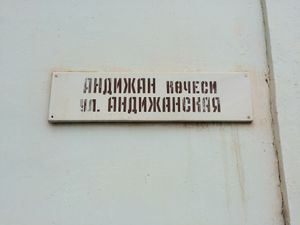
Where transliteration from the modern Turkmen alphabet is called for, it should be from modern Latinized Turkmen into the standard Latin alphabet, e.g., Aşgabat -> Ashgabat, Türkmenbaşy -> Turkmenbashy:
| ä | ç | ž | ň | ö | ş | ü | w | ý |
| a | ch | zh | ng | o | sh | u | v | y |
Mappers should avoid transliterating the Russian version of a name into Latin. Russian Cyrillic versions are themselves transliterations from the original Turkmen, in most cases, and furthermore often diverge from standard Turkmen spelling (e.g., Turkmen Garagum versus the Russian Каракум Karakum). As another example, it is incorrect to spell Ahal welaýaty (Ahal Province) as "Akhal velayaty", which would be the standard Cyrillic-to-Latin transliteration using the U.S. Board of Geographic Names transliteration scheme. The original Turkmen spelling, Ahal welaýaty, is correct, and the English transliteration is Ahal velayaty. By the same token, the town of Jebel should be rendered as Jebel, not as Dzhebel, a backformation of Джебель (since the Russian version of the Cyrillic alphabet has no equivalent to the letter "J", though the Turkmen Cyrillic alphabet does).
Transliteration from the Turkmen Cyrillic alphabet to the Turkmen Latin alphabet is relatively straightforward, as there is a one-to-one correspondence between most Turkmen Cyrillic letters and their Latin counterparts. The exceptions are the pairings of Cyrillic я and Latin ýa (as in Янбаш Ýanbaş), plus in some instances Cyrillic ë and Latin ýo (as in ëл ýol). The original Board on Geographic Names Romanization table for Cyrillic Turkmen may be found here.
Many cities and towns in Turkmenistan have undergone changes in spelling of their names since Soviet times. Authoritative spelling, per OSM guidelines, is what is on the official sign for a municipality. Hence, for example, the authoritative spelling of a village just north of Serhetabat is Çemenabat today despite past spellings as varied as Çemenibit and Çemenebit, both of which have appeared on official documents and maps. The town formerly known as Baharly is Bäherden, despite numerous documents and maps referring to it as Baharden. When in doubt, see if a Mapillary or KartaView ground-level image exists as a reference. A secondary source of authoritative spelling is the official Türkmenistanyň dolandyryş-çäk birliklerininň Sanawy ("List of Administrative-Territorial Units of Turkmenistan", Russian: Перечень административно-территориальных единиц Туркменистана). This list, which theoretically includes the names of all municipal as well as provincial and district structures in Turkmenistan as of January 5, 2018, is reproduced in the article Districts in Turkmenistan.[8]
Roads and Streets
Numbered highways in Turkmenistan use a combination of international and legacy Soviet numerations:
- AH - Asian Highway network
- Е - European E-road network
- М - legacy Soviet magistral'naya (магистральная) road, intended for long-distance transit traffic
- А - legacy Soviet interregional roads, intended for medium-distance inter-republic transit traffic; in the post-Soviet period treated as national highways. The letter "A" apparently refers to avtodoroga (автодорога), i.e., a road suitable for motor transport.
- Р - legacy Soviet republic-level roads, and in the post-Soviet period national highways. In Cyrillic this letter represents the sound "R" and apparently referred to "regional" (региональная); on both legacy Soviet maps in Cyrillic script and post-Soviet maps in Latin script this letter has not changed and today appears as the Latin letter "P". The P routes during the Soviet period were usually dirt or gravel roads and were only rarely paved with asphalt or concrete. In the post-Soviet period, many (but not all) of these routes in Turkmenistan have been paved, though road quality varies considerably. One, the P-1, was extended from Bokurdak to Koneurgench in the post-Soviet period and much of its section from Ruhubelent north almost to Koneurgench remains unpaved.
International Highways
Please consult European route E003, European route E60, European route E121, and M37 highway (Turkmenistan) in Wikipedia.
Asian Highway (AH) Network
See also the United Nations ESCAP Asian Highway (AH) route reference list at Asian Highway Database, excerpted below.
| AH | AH | Own Route | AH | Province/ | City/Town | City/Town |
| Route | Section | No./ | Design | State | Name at | Name at |
| No. | No. | Road Name | Standard | Name | Start Point | End Point |
| AH5 | 1 | M37/E60 | III | Lebap | Farap (Border of Uzbekistan) | Turkmenabat |
| AH5 | 2 | M37/E60 | III | Lebap/Mary | Turkmenabat | Bayramaly |
| AH5 | 3 | M37/E60 | III | Mary | Bayramaly | Mary |
| AH5 | 4 | M37/E60 | III | Mary/Ahal | Mary | Tejen |
| AH5 | 5 | M37/E60 | II, III | Ahal | Tejen | Ashgabat |
| AH5 | 6 | M37/E60 | I, III | Ahal/Balkan | Ashgabat | Serdar |
| AH5 | 7 | M37/E60, E121 | III | Balkan | Serdar | Bereket |
| AH5 | 8 | M37/E60, E121 | III | Balkan | Bereket | Gumdag |
| AH5 | 9 | M37/E60, E121 | III | Balkan | Gumdag | Balkanabat |
| AH5 | 10 | M37/E60, E121 | III | Balkan | Balkanabat | Turkmenbashy (Ferry Terminal) |
| AH70 | 1 | P-18/E121 | Below III | Balkan | Border of Kazakhstan (Garabogaz) | Garabogaz |
| AH70 | 2 | P-18/E121 | III | Balkan | Garabogaz | Turkmenbashy (Ferry Terminal) |
| AH70 | 3 | /E121 | III | Balkan | Serdar | Etrek |
| AH70 | 4 | /E121 | III | Balkan | Etrek | Gudurolum (Border of Iran) |
| AH75 | 1 | P-7 | III | Ahal | Tejen | Sarahs (Border of Iran) |
| AH77 | 1 | A-388 | III | Mary | Serhetabat (Border of Afghanistan) | Galaymor |
| AH77 | 2 | A-388 | III | Mary | Galaymor | Jct. to Tagtabazar |
| AH77 | 3 | A-388 | III | Mary | Jct. to Tagtabazar | Yoloten |
| AH77 | 4 | A-388 | III | Mary | Yoloten | Mary |
| AH78 | 1 | III | Ahal | Ashgabat | Gaudan Pass (Border of Iran) |
European E-road Network
E003 in Turkmenistan begins at the Uzbek border between Uchkuduk and Dashoguz, and proceeds via Ashgabat to terminate at the Gaudan Saddle on the Turkmenistan-Iranian border
E60 in Turkmenistan begins in Turkmenbashy and terminates at the border with Uzbekistan at the Farap border crossing.
E121 in Turkmenistan links Garabogaz border crossing to the border with Iran at Gudriolum via Turkmenbashy and Serdar.
See also WikiProject_Europe/E-road_network.
Legacy Soviet M-road Network
M37 in Turkmenistan connects the ferry terminal at the city of Turkmenbashy to the Farap border crossing via Ashgabat, Mary, and Turkmenabat.[9] The M37 is the major arterial highway across Turkmenistan. Wikipedia previously asserted that the M37 begins at the Garabogaz border crossing rather than at Turkmenbashy, but the Garabogaz-Turkmenbashy route has been designated P-18 in Turkmenistan's motor roads records, and the UN Asian Highway list excerpted above shows M37 as originating/terminating at Turkmenbashy, not Garabogaz. As of 29 September 2018 the M37 route inside Turkmenistan has been tagged ref=M37 and an M37 route relation has been added. It is not clear whether the M route designation is an "international" route designation, since it is a legacy of a defunct country now used by a national government, hence its tagging as ref=* rather than int_ref=*.
National Highways
These routes should usually be tagged as trunk routes highway=trunk. However, some little-used, unimproved, or primitive routes may deserve lesser categories. It is advisable to consult with local mappers or Mapillary or OpenStreetCam ground-level imagery before changing road classifications.
(As of 21 Sep 2018 bolded route numbers have been tagged with ref=* and route relations have been entered.)
- A-338 Mary to Yoloten, also known as Mary-Serhetabat Trassa
- A-381 Konyeurgench to Dashoguz via Boldumsaz, also known as Daşoguz-Köneürgenç Garaýoly
- A-388 Yoloten to Serhetabat, also known as Mary-Serhetabat Trassa
- P-1 Ashgabat to Koneurgench, north of Ruhubelent the road deteriorates markedly and is unpaved on much of that portion.
- P-3 Gokdepe to Ashgabat, specifically from M37 junction at Gokdepe to junction with Baba Annanow köçesi (current route of Kulyýew köçesi, attested in Soviet military map J-40-Б of 1986; route terminus at Baba Annanow junction is based on end of that highway at that junction as of the mid-1980s.)
- P-7 Tejen to Sarahs
- P-8 Sarahs to Serhetabat (not yet mapped; inside the border zone and thus off-limits to foreigners; reportedly a dirt road in poor condition)
- P-9 Sarahs to Mary via Hanhowuz (Hauzhan) (crosses M37 at Hanhowuz)
- P-10 Tejen to Tazeyol via Babadayhan (per Soviet military map J-41-B)
- P-15 Serdar to Iranian border via Etrek and Gudriolum (Gudurolum)
- P-16 Balkanabat to junction with P-15 via Esenguly
- P-17 from P-20 junction to Hazar via Oglanly and Jebel
- P-18 Turkmenbashy to Garabogaz border crossing with Kazakhstan
- P-20 Turkmenbashy to Chagyl (apm-wa reports that this road was intended to eventually reach to Koneurgench, but was never completed, and as of 2017 after the pavement ends at Chagyl the dirt track is in such poor condition that it may not be navigable.)
- P-21 Dashovuzskiy Fish Farm to Koneurgench (on old Soviet military maps it is marked as P-20; local officials advise the fish farm no longer exists)
- P-25 Gazojak to Yoloten via Bayramaly (On Soviet military map J-41-B of 1989, the section from Yoloten to Bayramaly is designated P-26.)
- P-28 A-388 via Tagtabazar to Afghanistan border near Başbedeň
- P-35 Uzbekistan border to Turkmenabat along south bank of Amu Darya
- P-36 Keleb to Turkmenabat via Kerki
- P-37 Kerkiçi to Kelif border crossing with Uzbekistan via Mugry and Koytendag
- P-38 from junction with P-35 south of Seydi along north bank of Amu Darya, to junction with P-39 via Turkmenabat
- P-39 Farap to Kerki
- P-47 Gurbansoltan Eje to Dashoguz (Soviet-era military maps indicate it goes onward to Boldumsaz; OSM reflects this)
- P-50 Akdepe to Gurbansoltan Eje
- P-53 Boldumsaz to Gulable
- P-89 Kerki to Uzbek border in direction of Karshy
- ???? Kerki to Ymamnazar (route number unknown at this time, but route has been tagged highway=trunk and name=Kerki-Ymamnazar ýoly)
Private Highway
China National Petroleum Company (CNPC) has constructed an asphalted high-speed highway known locally as "Hitaý ýoly" (English: "Chinese Highway" or Russian: "Китайская дорога") to serve CNPC facilities in Lebap province. Though freely open to passenger vehicles (trucks are prohibited), the Hitaý ýoly crosses into Turkmen frontier zones, so foreigners traveling on it require border permission in advance from the State Border Service.
Street Naming Conventions
- See also Gazetteer of Ashgabat Street Names
Turkmen Nomenclature
The following Turkmen words denote routes that in OSM are designated with the highway=* tag:
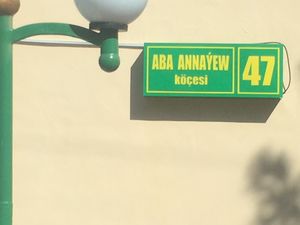
- gara ýol (highway, literally "black road", i.e., what in the United States is called a "blacktop")
- geçelge (alley, byway) (Note: The Soviet Turkmen term proýezd has been deprecated and should not be used.)
- köçe (street)
- öwrüm (circle, U-turn)
- şaýol (avenue, boulevard, prospect) (from şa "king, shah" + ýol "road")
- ýol (road) (Caution: ýol is a generic term essentially meaning "way" or "path" and thus can also be used to name a footpath, such as the Serdar ýoly aka Saglyk ýoly or "Health Walk" in Ashgabat.)
Turkmen grammar, as is the case with all Turkic languages, requires declension of nouns when they are modified by another noun, e.g., the name of the person, locale, or aspect in honor of which a street is named. Hence,
- Gökdepe gara ýoly
- Gorkiý geçelgesi
- Magtymguly köçesi
- Atamyrat Nyýazow şaýoly
- Aýlaw ýoly
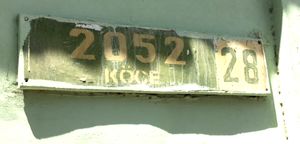
Numbered streets, however, remain in the nominative case:
- 2052 köçe
Russian Nomenclature
Owing to Russian influence between 1881 and 1991, Russian words (and obsolete Russian street names) are commonly used in reference materials and the spoken vernacular. They are, however, increasingly erased from signage. These terms are:
- бульвар (bul'var, boulevard, from the French)
- дорога (doroga, road)
- проезд (proyezd, alley, byway)
- проспект (prospekt, avenue, boulevard, prospect, from the French)
- трасса (trassa, track, road, calque from the French tracé)
- улица (ulitsa, street)
- шоссе (shosse, highway, calque from the French chaussée)
Russian names for streets should as a rule be recorded using the old_name=* tag, specifically old_name:ru=*. Exceptions to this rule are found where no signage exists, and the Russian name remains in common vernacular usage with no Turkmen variant, such as the Mary-Serhetabat Trassa.
Handling Errors and Discrepancies
Errors abound in signage. It is not uncommon to see the undeclined köçe on signage for named streets, particularly in provincial areas. Spelling is not always uniform, so streets named after the poet Andalyb may be signed Andalyb, Andalyp, or Andalip, all on the same street. In such cases one should be governed by the conventions of Turkmen orthographic rules. Alternative spellings may be entered in OSM using the alt_name=* tag.
It is also common to see a street named after a person with signs indicating both first and last names, only the last name, or first initial and last name, e.g., Döwletmämed Azady, Azady, or D. Azady. Here common sense should probably prevail, and name=* tag should be filled with whichever variant is most common on that street, with the other variants entered using the alt_name=* tag.
Misspelling is not uncommon, so in Täze Zaman one finds both Ebedilik and Ebediýlik. In this case, since the spelling is consistent along two separate sections of street, OSM reflects the actual signage and not the correct spelling (ebedilik means "eternity").
Certain provincial jurisdictions have adopted the odd convention of literally naming streets in honor of a person, e.g., "Döwletmämmed Azady adyndaky köçe", which translates to "Street named in honor of Dowletmammed Azady". Such lengthy official names should be recorded using the official_name:tk=* tag, and the name=* and name:tk=* tags should reflect the shorter and more commonly used form used in the vernacular, "Döwletmämmed Azady köçesi".
In contrast to western street naming conventions, the type of way is never capitalized on signage and should thus be left in lower case, e.g., "Beýik Saparmyrat Türkmenbaşy şaýoly", and not, "...Şaýoly".
Gas Stations
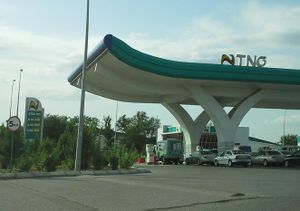
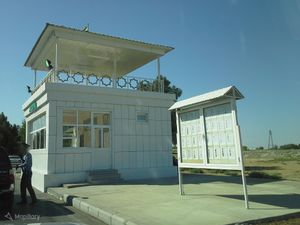
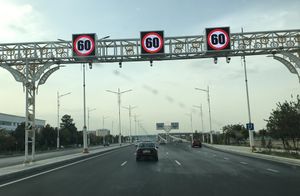

Turkmenistan has only one domestic petroleum company, the state monopoly concern Türkmennebit, a subsidiary of which, Türkmen Nebit Önümleri (Turkmen Petroleum Products), or TNO, is the sole producer of motor fuels. Hence all Turkmen gas stations should be tagged amenity=fuel and operator=TNO. In addition, all gas stations are numbered, and these numbers are useful as navigational landmarks. The naming convention is as follows, using gas station number 64 as an example:
name=AÝGS 64- name:en=Gas Station 64
- name:ru=АЗС 64 (АЗС is a formal contraction of the Russian автозаправочная станция "automobile refueling station" and is preferred to the slang term заправка.)
- name:tk=AÝGS 64 (AÝGS is a formal contraction of the Turkmen awtoulaglara ýangyç guýujy stansiýasy, literally "autotransport fuel pouring station". It is typically included in the signage of each gas station.)
ref=64
One may optionally add a location after the number, e.g., the name of the town or, in cities with multiple gas stations, the street it is on or colloquial name by which it is known locally. This assists motorists in locating gas stations on routes they are traveling, and is the method by which most locals will identify the station.
Turkmen gas stations typically (but not universally) offer 95-, 92-, and 80-octane gasoline as well as Diesel fuel. As of 2019, selected stations began offering "Eco-93" (Euro-5 standard 92-octane gasoline).[10] If offered at a particular station, these may be indicated by the appropriate tags: fuel:diesel=yes, fuel:octane_80=yes, fuel:octane_92=yes, fuel:octane_95=yes.
Mappers should add the ref=* tag to list the number of the gas station. This is of use in rendering maps, including the Garmin maps of Turkmenistan downloadable from http://garmin.openstreetmap.nl.
NOTE: Listing of a fuel type on the sign does not necessarily mean that fuel is available at that station; the existence of a fuel pump for each fuel type is authoritative, not what is written on the sign.
In August 2019, Turkmen state media reported that two new gas stations would be constructed in Lebap province.[11]
Police Checkpoints
Unlike traffic police in many other countries, who patrol highways in motor vehicles, traffic police in Turkmenistan are generally stationary and often are assigned to a fixed checkpoint on the highway. These checkpoints, which usually feature a permanent building, should be tagged amenity=police and name=PÝGG, the Turkmen contraction of Polisiýanyň Ýol Gözegçilik Gullugy "Police Road Inspection Service", i.e., traffic police bureau.
These traffic police posts are often the only publicly available source for names of highways in Turkmenistan. The sign on a PÝGG highway post will often identify the highway it serves, e.g., Daşoguz-Köneürgenç Garaýoly.
Border Crossings/Checkpoints
All thirteen of Turkmenistan's motor vehicle border crossings were mapped and labeled as of November 2018. These border checkpoints are staffed by personnel of the Turkmen customs, migration, and border services, and they usually also have a bank cashier on duty to exchange money and accept payments for border crossing fees.
A non-copyrighted list of border crossings between Turkmenistan and Uzbekistan can be found in Russian here. Ground truth has been collected on the Turkmen-Uzbek crossings at Koneurgench, Dashoguz, and Farap. The only border crossing with Kazakhstan as of 2019 was Garabogaz, but Turkmenistan citizens were not allowed to cross the border there; ground truth was collected on it in 2016 and 2018. As of 2018 there are four border crossings with Iran (Gudriolum, Bajgyran, Artyk, and Sarahs), and two with Afghanistan (Serhetabat and Ymamnazar).
The State Border Service of Turkmenistan also operates frontier zone checkpoints some distance from the actual border. See the Government Offices subsection, below. for tagging recommendations.
Speed Limits
The speed limit on major thoroughfares in urban areas is typically 60 kph. Between municipalities the maximum speed limit is typically 90 kph. School zones, congested areas, and other special zones may feature speed limits of 40 kph or 30 kph. Speed limit signs include overhead gantries, often equipped with radar cameras for issuance of speeding tickets, and roadside signs.
Points of Interest
Agriculture and Agribusiness
Major crops in Turkmenistan are irrigated wheat (bugdaý), rice (tüwi), and cotton (pagta). The cotton processing industry yields cotton fiber for the textile industry, cottonseed meal used in animal feed, and cottonseed oil, most of which is used as cooking oil. An extensive textile industry includes spinning plants for production of cotton yarn and textile mills for producing fabrics as well as ready-made garments. Shadehouse- and hothouse production of tomatoes, cucumbers, lettuce, and bell peppers is growing in importance, as are chicken- and dairy production.
Individual farmsteads are rarely encountered. "Farmer associations" (former collective and state farms from the Soviet era) were clustered, and today are usually classified as villages (obalar). Signage is inconsistent and may indicate the name of the farmer association, the village, the village council (geňeşlik), or a combination of all of them. Remote villages may have no external signage with the only indication of the village's name being a plaque on the town hall, school, or cultural center, if one exists.
Agriculturally related institutions include:
- Balygy ösdürip ýetişdirilýän we gaýtadan işlenil ýän önümçilik toplumy fish farming and processing complex.
landuse=aquaculture - Daýhan birleşigi (commonly contracted as d/b) farmer association or peasant association, successor to the Soviet-era collective or state farm (Russian: коллективное хозяйство or колхоз, советское хозяйство or совхоз).
place=village - Dokma toplumy literally textile complex, and can refer to a mill, factory, or plant.
industrial=textile,man_made=works - Egriji fabrigi spinning plant or factory.
man_made=works- Pagta ~ cotton ~
product=cotton_yarn - Ýüpek ~ silk ~
product=silk_thread - Ýün ~ wool ~
product=wool_yarn
- Pagta ~ cotton ~
- Galla elewatory grain elevator.
landuse=industrial,industrial=warehouse,product=wheat,product=rice, orproduct=rice;wheat - Galla önümleri kabul ediş noktady literally grain product receiving point, a rendering of the Russian: хлебоприемный пункт. A space, sometimes with sheds or roofs, for temporary dumping and weighing of harvested grain before delivering it to a grain elevator for long-term storage.
landuse=industrial,industrial=warehouse,product=wheat,product=rice, orproduct=rice;wheat - Guş toplumy poultry complex.
landuse=farmyard,crop=poultry - Pagta arassalaýjy fabrigi Cotton ginning plant or factory.
man_made=works,product=cotton;cottonseed - Pagta kabul ediş harmanhanasy literally cotton receiving shed, i.e., cotton yard. A space for stacking recently picked cotton prior to ginning and baling, sometimes in the open air despite the terminology.
landuse=industrial,industrial=warehouse,product=cotton - [Ösümlik] Ýag kombinaty literally [vegetable] oil combinate, i.e., cottonseed crushing plant.
man_made=works,product=cottonseed_oil;cottonseed_meal
Automobile Services
- Awto şaýlary car parts.
shop=car_parts - Awtoserwis car repair shop.
shop=car_repair- Ýag çalişmak oil change shop.
shop=car_repair,service:vehicle:oil_change=yes
- Ýag çalişmak oil change shop.
- Awtoýuwalga car wash.
amenity=car_wash - Wulkanizasiýa tire repair shop.
shop=car_repair,service:vehicle:tyres=yes
Banks
Please see Ashgabat: Banks. Only the domestic banks listed in that article have branches outside Ashgabat. The Turkmen word şahamça means English:branch or Russian:филиал.
Canals and Irrigation System
A desert country, Turkmenistan's agriculture and industry are heavily dependent on a canal network for delivery of water from the four major rivers. In addition to the Karakum Canal, a network of irrigation canals, drainage canals, and ditches criss-crosses most agricultural areas. As of May 2020 relatively little of this network as been mapped.
Catering
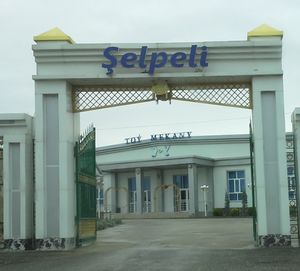
Food service in Turkmenistan falls into a small number of categories:
- Çaýhana teahouse, which typically offers a limited menu of prepared traditional Turkmen food in addition to tea. Tag as
amenity=fast_foodandfast_food=cafeteria. - Kafe café, from the French via Russian кафе. Tag as
amenity=cafe. - Naharhana cafeteria, in Turkmen literally "food house" or "meal house", virtually always serving traditional Turkmen food. Tag as
amenity=fast_foodandfast_food=cafeteria. - Restoran restaurant, calque of the French via Russian ресторан. Tag as
amenity=restaurant. Fast food "restaurants" or stands such as are found in shopping mall food courts may be tagged asamenity=fast_food. - Toý Mekany events venue, typically for weddings and baby showers, in Turkmen literally "celebration venue". A banquet hall banket zaly also falls into this category. Tag as
amenity=events_venue.
A toý mekany should not be categorized as a restaurant, as it is not a business into which one may simply enter and order a meal. It is, rather, a hall with an affiliated kitchen which must be booked in advance for social events, typically including a sit-down banquet.
Street food outlets in Turkmenistan, such as a hole-in-the-wall döner (kebab) kiosk, are typically unnamed and may be mapped with a node bearing the tag amenity=fast_food.
Bars and pubs are self-explanatory.
Cultural Institutions
- Kinoteatr (abbreviated as k/t) cinema, movie theater
amenity=cinema - Kitaphana library
amenity=library - Medeniýet culture
- Muzeý museum
tourism=museum- Tarih Muzeýi history museum
- Seýilgäh park
leisure=park - Teatr theater
amenity=theatre- Gurjak Teatry puppet ~
- Drama Teatry drama ~
- Saz Teatry music ~ or concert hall
Diplomatic and Consular Missions
The Turkmen Ministry of Foreign Affairs lists diplomatic and consular missions accredited in Turkmenistan in English, Russian, and Turkmen. The ministry's website is copyrighted, so all information on these missions entered into OSM has been collected by ground truth between 2015 and 2020. Tag with office=diplomatic and either diplomatic=embassy or diplomatic=consulate. Tertiary tags embassy=* consulate=* may also be added.
Educational Institutions
Educational institutions are patterned after Soviet models, and include:

- Çagalar Bagy kindergarten, equivalent to and direct translation of Russian детский сад
amenity=kindergarten - Çagalar Bakja-Bagy day care center and kindergarten, equivalent to Russian ясли-детский сад
amenity=kindergarten - Institut institute, a calque of the Russian word институт (itself a loan word from German)
amenity=universityNote: The term institut is also applied to research institutes, which are not always also degree-granting educational institutions. - Konserwatoriý music conservatory, a calque of the French via Russian conservatoire
amenity=music_school - Orta Mekdep secondary or middle school, direct translation of Russian средняя школа
amenity=school - Orta Hünar Okuw Mekdebi vocational secondary school, equivalent to Russian средне-специальное училище
amenity=school - Orta Okuw Mekdebi secondary training school, typically for technical professionals, such as nurses and paramedics
amenity=school - Okuw Terbiýeçilik Toplumy training complex, usually for pursuit of advanced professional training in a technical discipline (e.g., nursing, oil and gas)
amenity=college - Uniwersitet university, a calque from the Russian word университет (itself a loan word from German)
amenity=university
Kindergartens and secondary schools are usually numbered, but some also bear a name in honor of someone, e.g.,
- 64-nji Ene Kuliýewa adyndaky Orta Mekdep, Ene Kuliyeva Secondary School No. 64
Vocational and specialized secondary schools typically indicate the technical specialty in their names, e.g.,
- Daşoguz Lukmançylyk Orta Okuw Mekdebi, Dashoguz Medical Training Secondary School
Other specialties or particular features include but are not limited to:
- internat boarding school
- medeniýet culture
- saz music (since this is typically a regular secondary school with an added music program, should be tagged
amenity=school) - sport sports
- sungat art
- ýörite special
- zehinli çagalaryñ for gifted children
- aýratyn ~ for especially gifted children
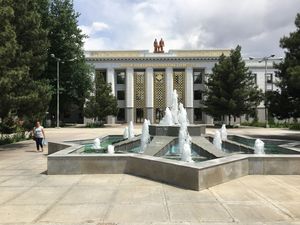
Specialized post-secondary institutions typically indicate the major focus of study, such as:
- Jemagat Hojalygy Instituty Public Utilities Institute
- Saglygy Dikeldiş Okuw Terbiýeçilik Toplumy Training Complex for Health Restoration
- Halkara Nebit we Gaz Uniwersiteti International Oil and Gas University
Post-secondary institutions may be named in honor of someone in addition to having a formal designation, such as
- Magtymguly adyndaky Türkmen Döwlet Uniwersiteti, literally "Turkmen State University named for Magtymguly", normally rendered in English as "Magtymguly Turkmen State University" in much the same way we would refer to Stanford University or Yale University, both of which were also named after individuals. N.B. that in this case, "state university" means "public university", as in the state that is Turkmenistan, and does not bear the same meaning as in the United States (sponsorship by a state of the union, e.g., California State University).
- Türkmenistanyň Oguzhan adyndaky Inžener-Tehnologiýalar Uniwersiteti, literally "Turkmenistan's Engineer-Technologies University named for Oguzhan", but less clumsily and more precisely rendered in English as "Oguzhan Turkmen Engineering Technologies University".
A list of post-secondary educational institutions in Turkmenistan can be found here in Russian and here in Turkmen.
Government Offices
Normal OSM tagging recommendations apply.
- The main office of a häkim (governor or mayor, see above) is a häkimlik. The häkimlik of a city, borough, or district should be tagged as the town hall.
amenity=townhallbut of a province (welaýat) as a governor's officegovernment=administrative,office=government - Geňeş village (oba) or town (şäherçe) council (see above)
amenity=townhall - Kazyýet courthouse
amenity=courthouse - Maliýe we Ykdysadyýet finance and economics
government=economics;finance,office=government - Milli Howpsyzlyk national security
government=security,office=government - Prokuratura prosecutor
government=prosecutor,office=government - Salgyt Gullugy tax service
government=tax,office=government - Serhet Gullugy border service
landuse=military military=checkpoint name=Serhet Gullugy Barlag Punkty name:en=State Border Service Checkpoint name:ru=Контрольный пункт пограничной службы name:tk=Serhet Gullugy Barlag Punkty
building=yes government=customs;migration;military military=checkpoint name=city Border Checkpoint name:en=city Border Checkpoint name:ru=city пограничный пункт name:tk=city Serhet Barlag Punkty office=government
Health Care Facilities
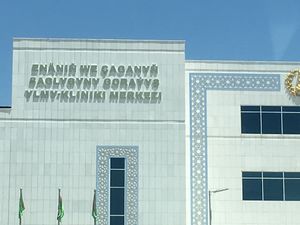
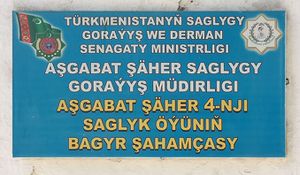
Please see How to Map Hospitals.
According to the Ministry of Foreign Affairs website, Turkmenistan boasts 122 hospitals, most of them in rural areas.[12] According to the 2020 Turkmenistan Statistical Handbook, as of the end of 2019 there were 41 municipal outpatient clinics (Saglyk Öýi) and 135 hospitals.[13]
Turkmen health care facilities are patterned after their Soviet forebears:
- Dermanhana pharmacy or apothecary (chemist's), equivalent to Russian аптека
amenity=pharmacyandshop=chemist - Hassahana hospital (literally, "sickness building"), equivalent to Russian больница
amenity=hospital- Çagalar ~ children's ~ , equivalent to Russian детская ~
healthcare:speciality=paediatrics - Köpugurly ~ general ~ , equivalent to Russian многопрофильная ~
healthcare:speciality=general - Tiz Kömek ~ emergency ~, equivalent to Russian ~ неотложной помощи or скорой помощи
healthcare:speciality=emergency
- Çagalar ~ children's ~ , equivalent to Russian детская ~
- Saglyk Öýi or Saglyk Merkezi clinic (literally, "health house" or "health center"), equivalent to Russian поликлиника
amenity=clinicThese are outpatient facilities and should not be tagged as hospitals. - Şypahana sanatorium (literally, "cure house"), equivalent to Russian курорт or санаторий
healthcare=sanatorium. As of March 2019 only six of 15 sanatoria in Turkmenistan have been mapped. - Tiz Kömek ambulance (literally, "urgent assistance", i.e., "first aid"), equivalent to Russian скорая помощь
amenity=ambulance_station
Specialty hospitals may be named merkez "center" prefixed by the specialty, e.g., Onkologiýa Merkezi "Oncology Center". Maternity and pediatric hospitals Çaga Dogrum Hassahanasy are often named Ene Mähri "Mother's Love". Dental clinics and hospitals are normally identified by the noun stomatologiýa "stomatology, dentistry", e.g., Stomatologiýa Merkezi.
N.B. Tiz Kömek on a hospital means "Emergency" (Tiz Kömek Hassahanasy is "Emergency Hospital") but Tiz Kömek or Tiz Lukmançylyk Kömegi on a vehicle means "Ambulance". A garage labeled Tiz Kömek should be tagged amenity=ambulance_station.
Private clinics should be tagged as clinics, not as amenity=doctors. The amenity=doctors tag should be applied only to private physicians' offices, which effectively do not exist in Turkmenistan. Private clinics and hospitals, however, though rare do exist, such as the Diamed Clinic in Ashgabat.
Hotels
According to the 2018 Statistical Yearbook of Turkmenistan, as of 2017 Turkmenistan had 104 hotels, distributed as follows:
| 2016 | 2017 | |
| Ashgabat city | 38 | 40 |
| Ahal Provice | 4 | 4 |
| Balkan Province | 35 | 35 |
| Dashoguz Province | 6 | 6 |
| Lebap Province | 7 | 7 |
| Mary Province | 12 | 12 |
The Awaza National Resort Zone of the city of Turkmenbashy accounts for the relatively large number of hotels in Balkan Province. The Turkmen word for hotel is myhmanhana, though the term otel, a calque of French hôtel via Russian, is commonly encountered. As of 2022 two new hotels had opened in Ashgabat, the Garagum Hotel near the airport, and the Hotel Arkadag, between Çandybil şaýoly and Arçabil şayoly. A new hotel is also planned for the new Ahal Province capital, Arkadag. Tag as amenity=hotel.
An increasing number of Turkmen offer guest house services, but often mistag them as hotels. These should be tagged tourism=guest_house.
Retailing and Business
Retail occupancies come in many types, ranging from large, modern shopping malls to traditional open-air markets, from kiosks to multifloor retail buildings. They include:


- Dükan shop, a loanword from Aramaic via Arabic (should be tagged as
shop=*).- Azyk Harytlary ~y grocery ~, translation of Russian продуктовый магазин, and depending on size can be tagged as either
shop=convenienceorshop=supermarket. - Gatyşyk Harytlar ~y literally "variety goods" ~, should be tagged as
shop=convenience. - Gurluşyk Harytlary ~y construction materials ~, should be tagged as either
shop=hardwareorshop=doityourself. - Ofis we Mekdep Harytlary ~y office and school supplies ~, should be tagged as
shop=stationery.
- Azyk Harytlary ~y grocery ~, translation of Russian продуктовый магазин, and depending on size can be tagged as either
- Gündogar Bazary oriental bazaar, a more traditional market, often at least partially open-air (should be tagged
amenity=marketplace). - Kärhana enterprise, equivalent to the Russian предприятие, and functionally similar to the English "company". Tag will vary depending on function, and could be
shop=*,office=company, or something else.- Döwlet ~ state ~, a government-owned and -operated enterprise.
- Hususy ~ private ~, a privately owned and -operated enterprise.
- Konsern calque of the English word "concern", a company, almost invariably owned by the Turkmen government, such as the Türkmengaz Döwlet Konserni, Turkmengas State Concern. Tagging will vary depending on type of company the point of interest is.
- Köpugurly Söwda Bazary one of five large oriental bazaars located on the outskirts of Ashgabat, Balkanabat, Dashoguz, Mary, and Turkmenabat; should be tagged
amenity=marketplace. - Market grocery store, calque of the English word "market", usually the size of a convenience store unless it is part of a chain; tag as
shop=convenienceorshop=supermarket. - Söwda Merkezi mall, a direct translation of the American term "shopping center" via Russian "торговый центр" (tag as
shop=mall). - Söwda Alyş Dynç Merkezi another type of mall that includes amusements, such as a cinema and indoor play area for children, as well as a food court, direct translation of Russian торгово-развлекательный центр (tag as
shop=mall). - Ussahana repair shop, typically not for motor vehicles, however (car repair shops are usually named awtoserwis
shop=car_repair). N.B. ussahana is also used for industrial repair shops, such as a railroad locomotive repair shop or teplowoz ussahanasy. There is no specific tag for most repair shops (car repair is an exception), so use the tag for the specific item that can be repaired here plusrepair=yes, e.g.,
Major retail chains in Turkmenistan include Kämil Market, Halk Market, and Şazada. Turkmenistan's lone department store, Ýimpaş, was closed in December 2016, so the tag shop=department_store should not be used in this country.
The oriental markets mentioned above in four of Turkmenistan's provincial capitals (Balkanabat, Dashoguz, Mary, and Turkmenabat) and the national capital, Ashgabat, are laid out in the form of the rosette (göl) representing the dominant tribe of that province on the national flag. They are sufficiently large that if possible these markets should be mapped to indicate what part of the marketplace is devoted to trade in what types of goods. As of 2019 the Balkanabat oriental bazaar was used exclusively for wholesaling and warehousing. An oriental bazaar is planned for the new Ahal Province capital, Arkadag, but as of late 2022 that bazaar had not yet been built.
Infrastructure Projects
Airports
The government of Turkmenistan has built a new airport in Kerki (former Atamyrat) in Lebap Province and plans to build a new airport in Garabogaz (former Bekdash) in Balkan Province. In January 2019 state mass media reported plans to build a passenger terminal at the Galaymor Airport.[14] The new Turkmenabat International Airport was completed in February 2018.
- Президент Туркменистана провёл совместное заседание Кабинета Министров и Госсовета безопасности 19 May 2018
Flood Control
In July 2020 construction began of flood and mudslide control lagoons south of Ashgabat's Köpetdag şaýoly.[15][16]
Highways
"Autobahns" (Motorways)
The Turkmenistan government proposes to build six-lane "autobahns" (Turkmen: awtoban, plural awtobanlar; Russian: автобан), in reality limited-access tollways, connecting Turkmenbashy and Ashgabat, and Ashgabat and Turkmenabat. Each autobahn is to be approximately 600 kilometers long, and to bypass population centers. Construction cost is projected to be $4 million per kilometer. According to press reports, the autobahn construction will involve addition of motels, gas stations, pharmacies, and rest areas. As constructed, these "autobahns" should most likely be tagged highway=motorway, based on the descriptions provided so far.
The timeline for construction of the Ashgabat-Turkmenabat section was published in January 2019 as follows:
- Ashgabat–Tejen December 2020
- Tejen–Mary December 2022
- Mary–Turkmenabat December 2023[17]
Although the autobahn was scheduled to have been completed by December 2023, as of January 2024 it remained under construction.[18]
State daily newspaper Neytral'nyy Turkmenistan reported 25 January 2019 that the Ashgabat-Turkmenabat section of the "autobahn" will have eight lanes, consisting of three primary lanes plus one "additional" (presumably emergency) lane in each direction, and will be 34.5 meters wide. This section will start at an intersection with the P-1 highway at Kilometer 24 north of Ashgabat. This section will include four river bridges, four bridges over rail lines, 22 flyovers of other roads, underpasses for livestock, 76 pedestrian underpasses, culverts, and 10 "stations" (no further information). Total cost of the Ashgabat-Turkmenabat section is projected at $2.3 billion.[19] The same newspaper reported 18 March 2019 that a consortium named Türkmen Awtoban consisting of four Turkmen construction firms (Altyn Nesil, Hyzmat Merkezi, Oguz Ýol, and Nusaý Ýollary) will build this section of the motorway, and that right-of-way preparation is underway on the first 100 kilometers.[20]
Turkmen state media reported in October 2021 that the Ashgabat-Tejen section had been completed and inaugurated by the nation's president.[21][22]
Additional details are available from the following news articles:
Ashgabat-Turkmenbashy
- Скоростной автобан Ашхабад – Туркменбаши уже строится 20 June 2016
- Автобан Ашхабад-Туркменбаши выведет транспортно-логистический рынок страны на новый уровень 17 March 2017
- Ашхабад и Туркменбаши соединит высокоскоростной автобан 18 March 2017
- Автобан Ашхабад-Туркменбаши расширит международную транзитно-транспортную инфраструктуру 29 October 2017
- Polimeks stops building Ashgabat-Turkmenbashi highway amid Turkmen budget woes 1 March 2018
Ashgabat-Turkmenabat
- President Gyrbanguly Berdimuhamedov met with the representatives of domestic business 08 June 2016
- Предприниматели Туркменистана построят автобан Ашхабад-Туркменабат 17 March 2018
- Turkmen entrepreneurs to build Ashgabat-Turkmenabat highway 17 March 2018
- Turkmenistan will build Ashgabat – Turkmenabat Autobahn 19 June 2018
- Türkmen Awtoban CJSC to Design and Construct Ashgabat–Turkmenabat Highway 11 January 2019
- Туркменистан формирует мультимодальную логистическую систему регионального значения 25 January 2019
- Зять Гурбангулы Бердымухамедова – один из застройщиков туркменского автобана за $2,3 млрд (видео) 1 July 2019
- Ashgabat – Turkmenabat Highway Construction Underway 30 September 2019
Major Through Routes
According to the Turkmen Motor Roads State Concern (Türkmen Awtoýollary Döwlet Konserny) the M37 highway that connects Turkmenbashy seaport to the border with Uzbekistan at Farap is under renovation planned to be complete by the end of 2019. At that point the entire M37 road should be a dual carriageway of at least two lanes in each direction, and should mainly be a divided highway. As of August 2018 all bridges had been constructed along the route and roadbed preparation, grading, ballasting, and paving of the additional carriageways were underway.
In addition, the P-3 route, which includes Kulyýew köçesi (former 2127 köçe), is under reconstruction between the Yzgant turnoff and Gökdepe. When that is completed, it is anticipated that Kulyýew will become a northern bypass route around both Ashgabat and Gökdepe, facilitating through traffic. Whether the M37 route number will be reassigned from Gurban Soltan Eje to P-3 is uncertain at this time (September 2018).
Mass media reported in April 2019 on intentions to renovate and widen the 225-kilometer route between Turkmenbashy city and the border with Kazakhstan, currently the P-18 highway.[23] The road will be widened to 22.5 meters and a new 354-meter-long, 21-meter-wide bridge will be built across the Garabogaz Lake inlet from the Caspian Sea. The route between Garabogaz and the border is currently unpaved, based on field observations in February 2016. In June 2022 state media announced that a presidential decree had been signed authorizing conclusion of a contract with Altcom of Ukraine to construct a bridge across Garabogaz Lake.[24]
Hospitals and Clinics
State daily newspaper Neytral'nyy Turkmenistan reported in February 2019 that private construction company Ajaýyp-gurluşyk had been hired to build in Dashoguz a general "clinic" with 450 beds and oncology "clinic" with 150 beds, with construction projected to be complete by December 2021.[25] Four hospitals have been built in the new Ahal Province capital of Arkadag. As of March 2023 three more specialized hospitals are under construction in Ashgabat, an international oncology center, international pediatric center, and dental center.[26]
Natural Gas Pipelines
Turkmenistan's national gas company is Türkmengaz, called in English Turkmengas. Additional gas companies operating in Turkmenistan, all foreign, include China National Petroleum Company, Petronas, Enex, and Areti. Gas condensate is extracted from 30 fields, including the Döwletabat, Şatlyk, Malaý, Kerpiçli, Garaşsyzlygyň 10 ýyllygy, Gazlydepe, Bagaja, Garabil, and Gurrukbil gas plays in the central Karakum Desert.[27] The Galkynyş (Galkynysh in transliteration) gas field is considered the second largest in the world.
The Turkmenistan-Afghanistan-Pakistan-India gas pipeline project (TAPI) is to involve laying of a 56" gas pipeline from somewhere in the Galkynysh gas field south of Yolöten to the Turkmenistan-Afghanistan border near Serhetabat. In Afghanistan and Pakistan, parallel to the gas pipeline, fiber optic cable will be laid and a road will be constructed. Satellite imagery indicates that the feeder pipeline route may run from approximately N 37.14992, E 62.20013 to N 35.38023, E 62.17912, but this has not been confirmed.
Further information is available from these sources:
- New stage of construction of TAPI project starts on February 23 16 February 2018
- TAPI project contract signed in Ashgabat 24 January 2018
- Turkmenistan – Afghanistan – Pakistan – India Gas Pipeline (TAPI) undated
- Turkmenistan- Afghanistan – Pakistan-India (TAPI) Pipeline undated
- The Taliban declared the TAPI gas pipeline a national project and promised its protection 22 February 2018
The East-West gas pipeline was completed in December 2015, but to date (June 2018) has not been mapped.
- Turkmenistan Completes East-West Pipeline: What's Next? 29 December 2015
- Turkmenistan boosts gas export capacity with East-West link 23 December 2015
Line D of the Central Asia–China gas pipeline remains under construction.
New Administrative Center for Ahal Province
- Main article: Arkadag
At the end of October 2018 the Cabinet of Ministers reviewed proposals for creation of a new administrative center for Ahal Province, to be located south of Gorjaw, north of the village of Aba Annayew, and east of Gökdere ýoly, at approximately N 38.0612, E 58.0566.[28][29][30]
Five different architectural proposals were presented to the Cabinet of Ministers, initially ranging in land area from 862 to 880 hectares, with enough new housing to accommodate over 67 thousand residents.[28] On 16 March 2019, the government announced selection of a project covering 950 hectares that will house 70 thousand residents and include an international higher equestrian school.[31] According to Chronicles of Turkmenistan, the new administrative center will include apartment buildings, a flagpole area, buildings of the mayor's office and other offices, as well as a Palace of the Soul, provincial education and culture departments, a drama theater, a library, and an international hospital for infectious diseases.[16]
Satellite imagery dating to late 2020 indicated that the new administrative center was under construction by that time. On 20 December 2022, although construction remained incomplete, the National Assembly of Turkmenistan passed a decree naming the new administrative center "Arkadag" in honor of former President Gurbanguly Berdimuhamedov and designating it the capital of Ahal Province.[32]
Power Stations and Electricity Lines
As of May 2019 Turkmenistan has 12 electrical power stations with total design capacity of 6.7216 gigawatts. They feature 36 gas- and 12 steam turbines.[33] This is an increase since 2015, when Turkmenistan had 11 power plants consisting of 14 steam-turbine and 26 gas-turbine units. In 2015 the capacity of gas-turbine power plants was 2.3 gigawatts, about half of installed capacity at that time of 4.674 gigawatts.[34] As of 2015, gas-turbine power plants of 149-megawatt capacity had been commissioned in Ahal, Mary and Lebap provinces. A gas-turbine power plant with a capacity of 252.2 megawatts was constructed in Ak bugdaý etraby, as was the Derweze power station in Ahal province with 504.4-megawatt capacity. As of 2015 construction was underway of two gas-turbine power plants in Lebap province, one with 252.2-megawatt capacity and another at Zerger, Çärjew etraby, with 400-megawatt capacity. When completed, the Zerger plant will consist of three Mitsubishi Hitachi Power Systems M701DA gas-turbine units producing 400 megawatts.[34][35]
Not all gas-fired electrical power stations have been mapped. A new 1.5 gigawatt power plant was commissioned 8 September 2018 outside Mary and has now been mapped. The Zerger power plant in Çärjew etraby, Lebap, remains to be mapped.
As of July 2020 construction had begun on an electric power ring to connect Ahal province to Balkan province and Balkan province to Dashoguz province. The first segment will cover 450 kilometers, and the second 560 kilometers, with transmission voltage of 500 kilovolts. The ring system will include two substations of 500/220/110 kilovolts and 220/110 kilovolts. The general contractor is the Turkish firm Çalık Enerji. [36]
Railroads
The main railway operator in Turkmenistan is government-owned Türkmen Demir Ýollary or Turkmen Railroads (literally, "Turkmen Iron Roads"). Some short lines are operated by the state concern Türkmengaz, the national natural gas company.
Main Lines
The "Kushka Railroad" (Russian: Кушкинская железная дорога) was built in the 1880s by the Russian Empire to connect Krasnovodsk (today's Turkmenbashy) to Kushka (today's Serhetabat) for two purposes: to haul cotton from the Murghab River valley out for shipment to textile mills in Russia, and to ferry Russian troops in to defend the southern border of the empire. The railway was later incorporated into the Transcaspian Railroad (Russian: Закаспийская железная дорога), with the route's extension from Mary to Çärjew (today's Turkmenabat), and onward to Uzbekistan. A branch line from Çärjew to Dashoguz was extended to Moscow. The Ashgabat-Dashoguz direct line, sometimes referred to as the Transkarakum Railroad, was built after independence.
Kazakhstan-Turkmenistan-Iran Rail Line
On December 3, 2014, the north-south rail line connecting Kazakhstan and Iran via Turkmenistan was inaugurated. It passes through Bereket, where it intersects with the main east-west rail line from Turkmenbashy to points east. Much of the line has been mapped but sidings, spurs, and some other affiliated POIs remain works in progress. Total length in Turkmenistan, including sidings, is 825 kilometers.[37]
| List of Railway Stations on the Kazakhstan-Turkmenistan-Iran Railroad, per Turkmenistan Parliamentary Resolution No. 347-IV, 20 October 2012 | ||
| Bereket-Serhetýaka Section | ||
| No. | Station Name | Distance from Bereket |
| 1 | Akýol | 22.85 |
| 2 | Arzuw | 45.9 |
| 3 | Ýasga | 71.8 |
| 4 | Burgun | 106.6 |
| 5 | Uzboý | 134.8 |
| 6 | Gökdere | 159.75 |
| 7 | Gyzylgaýa | 185.3 |
| 8 | Awlamyş | 208.0 |
| 9 | Ersäribaba | 230.2 |
| 10 | Berkarar | 262.0 |
| 11 | Bitaraplyk | 288.8 |
| 12 | Hazar | 313.4 |
| 13 | Kuwwat | 338.0 |
| 14 | Parahat | 358.7 |
| 15 | Polatly | 381.8 |
| 16 | Şanly | 418.8 |
| 17 | Serhetýaka | 440.7 |
| Bereket-Etrek Section | ||
| 1 | Däneata | 32.0 |
| 2 | Döwletýar | 74.0 |
| 3 | Bugdaýly | 103.0 |
| 4 | Balguýy | 132.0 |
| 5 | Madaw | 172.0 |
| 6 | Akjadepe | 198.0 |
| 7 | Etrek | 223.0 |
| 8 | Akýaýla | 256.5 |
Rail Lines to Afghanistan
A new line connecting Kerki with Ymamnazar and crossing the Afghan border to Aqina was inaugurated in 2016. That line has been accurately mapped as far as Ymamnazar based on GPS traces collected just before and after the dedication ceremony. Mapping south of Ymamnazar is approximate and is based on recent satellite imagery, thus could benefit from ground-level validation. Total length inside Turkmenistan of this line is 88 kilometers.[37]
The old rail line from Serhetabat (former Kushka) to Torgundi in Afghanistan was renovated in 2017 and put back into service. That line has also been largely mapped based on updated imagery but could use ground-level validation. The governments of Afghanistan and Turkmenistan intend to extend this line to Herat, where it will connect to a recently constructed rail line between Herat and Khaf, which in turn connects to a rail line leading to Iran's Chabahar seaport.
The Turkmenistan-Afghanistan-Tajikistan rail line project remains on the drawing board.
Residential Construction
Official government daily newspaper Neytral'nyy Turkmenistan reported 9 January 2019 on plans to build eight kindergartens, six secondary schools, a house of culture, two clinics, and a wedding palace plus 184 9- and 15-story apartment buildings, a 1500-seat sports complex, and park in Bagtyýarlyk borough of Ashgabat between 2020 and 2030. The Turkmen government plans to build a new national music conservatory in Ashgabat but the location is yet to be determined.[38] An expansion of the Gurtly Residential Complex development in Ashgabat was announced 18 February 2019, to include 62 four-story apartment buildings as well as ancillary structures.[39] Neytral'nyy Turkmenistan reported 21 February 2019 on plans to build 17 32-unit apartment buildings and 170 two-story single family dwellings in Turkmenabat.[40]
In December 2019 state media reported on opening of a new village in Balkan province, named Rowaç; the start of construction of the new administrative center for Ahal Province as well as a new "social-production complex" in Serdar district near the Altyn Asyr ("Golden Age") artificial lake. Media also reported that new modern towns had been started in Çärjew, Saýat, Halaç, and Kerki districts of Lebap province; and in Türkmengala, Sakarçäge, and Wekilbazar districts of Mary province. Plans were announced for construction of a "large complex of residential houses and public buildings" in the district named for S.A. Nyýazow in Dashoguz province.[41][42]
State media reported in August 2023 on plans to build in the town of Guwlymaýak, Balkan Province, "Six four-story 32-apartment, four 40-apartment and two 60-apartment residential buildings, one comprehensive secondary school for 320 children, one kindergarten for 120 children and one shopping and entertainment center."[43]
State media reported in April 2024 that construction was nearing completion of a new residential complex with 70 apartment buildings between downtown Daşoguz and that city's airport.[44]
State media reported in February 2025,
This year, it is planned to commission modern villages in the gengeshliks of "Öňaldy" in the Ak Bugday etrap and "Gowşut" in the Kaakhka etrap of the Ahal velayat, new modern villages in the Gyzylarbat etrap of the Balkan velayat, a new modern settlement in the Koneurgench etrap of the Dashoguz velayat, a road bridge across the Garabogazkol Bay in the Balkan velayat, an international airport complex in the town of Jebel in the Balkan velayat. It is also planned to commission the Mary-Turkmenabat section of the Ashgabat-Turkmenabat high-speed highway, a higher educational institution of the Union of Industrialists and Entrepreneurs of Turkmenistan.[45]
See Also
OSM Wiki Articles on Geographic Names:
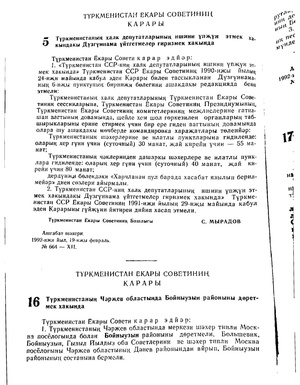


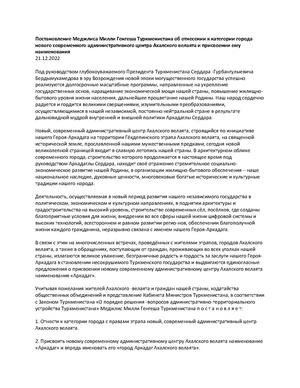
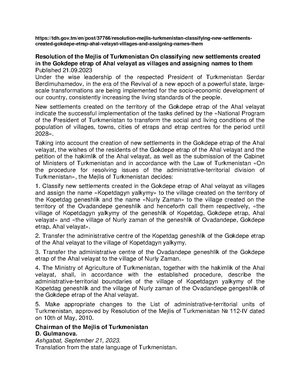
- Districts in Turkmenistan (authoritative list of provinces, cities, towns, and villages as of 26 February 2025)
- Turkmenistan Geoname Changes (partial list of legislative acts and executive decrees ordering changes of geographic names since 1991, and key to transliteration from Turkmen Cyrillic to Turkmen Latin alphabet)
OSM Wiki Articles about Provinces of Turkmenistan:
OSM Wiki Articles about Cities of Turkmenistan:
Reference Materials
Most recent
- Рассмотрены вопросы совершенствования административно-территориального устройства велаятов 22 October 2022
- Постановление Меджлиса Милли Генгеша Туркменистана 10 November 2022
- Türkmenistanyň Milli Geňeşiniň Mejlisiniň Karary 10 November 2022
- Постановление Меджлиса Милли Генгеша Туркменистана об отнесении к категории города нового современного административного центра Ахалского велаята и присвоении ему наименования 20 December 2022
Historical
- Административное деление Туркмении (Russian Wikipedia: Administrative Division of Turkmenia CAUTION: Appears not to have been updated since 2015, so is out of date.)
- Бердымухамедов переименовал населенные пункты, названные в честь Ниязова Regnum, 28 November 2017
- Глава государства сменил руководство Лебапского велаята TurkmenInfo, 28 November 2017
- Law on Administrative-Territorial Structure of Turkmenistan, in Russian (О порядке решения вопросов административно-территориального устройства Туркменистана)
- List of Cities in Turkmenistan (Turkmenwiki, in Russian) (includes former names for reference)
- List of Cities in Turkmenistan (Wikipedia, in English, updated April 2021)
- List of Cities in Turkmenistan (Wikipedia, in Russian) (includes former names for reference)
- List of Districts of Turkmenistan (Wikipedia in English) (updated April 2021)
- List of Renamed Cities in Turkmenistan (Wikipedia, in English)
- List of Towns in Turkmenistan (Wikipedia, in Russian) {CAUTION: Not fully up to date as of 19 May 2018; use with caution!)
- О Пунктах Пропуска Через Государственную Границу (only Turkmenistan-Uzbekistan)
- Посёлки городского типа Туркмении (ruwikiorg)
- Provinces of Turkmenistan (Велаяты Туркменистана) (in the Russian language)
- SOTM 2016 Presentation on Mapping in Turkmenistan
- Toponym Dictionary of Turkmenistan, Ashgabat: Ylym, 1970 (in the Turkmen language and Cyrillic script)
- Трассы (нумерация) (Numbering of Post-Soviet Roads)
- Turkmen Alphabets (Wikipedia, in Russian)
- Turkmenistan page on Academy of Sciences website (in the Russian language)
Вы можете помочь! You can help!
- Turkmenistan Data Corrections #83 (Github) This task outlines work to improve map data in Turkmenistan based on app user feedback.
- Контроль качества (TM-FULL) Use this tool to find problems you might be able to correct (in Russian)
- Turkmenistan in Mapillary ground-level imagery
- Turkmenistan in OpenStreetCam ground-level imagery
- Public GPS traces tagged "Turkmenistan"
- Admin Level tag usage in Turkmenistan
Here are a few things you can do to help improve the Turkmenistan map: Вот некоторые вещи, которые вы можете сделать, чтобы помочь улучшить карту в Туркменистане:
- Locate missing towns / Найти отстутсвующие посёлки. They are listed in red on this list / Они отмечены красным цветом на этом списке: Turkmenistan Geoname Changes#Towns.
- Перевести эту статью на русский и туркменский языки.
- Add major canals and waterways / Добавить важные каналы и реки/речки/коллекторы.
- Add missing gas stations and annotate existing ones with their numbers. Добавить отсутствующие заправочные станции и номера существующих станций.
- Add residential roads NW of Balkanabat using updated imagery Добавить улицы и дороги на северозападе от Балканабата пользуясь обновлённой спутниковой съёмкой.
- Update street names in Balkanabat to current Turkmen names from the obsolete Russian names.
- Many villages and towns are missing around Mary and Bayramaly. Отсутствуют сёла и посёлки около Мары и Байрамали.
- Bus stops and bus routes in major cities! Остановки и маршруты автобусов в крупных городах!
- Identify using the name=* tag unidentified villages, and update any Soviet-era names to current Turkmen official names.
- Add information useful to other mappers to the OSM wiki articles about cities and provinces of Turkmenistan.
References
- ↑ 1.0 1.1 Ораев, Нурмаммет (1985). “Экономическая География Туркменской ССР”. Магарыф.
- ↑ Wikipedia: List of deserts by area
- ↑ “Город-спутник столицы республики Туркмении - Безмеин переименован в Абадан” (in Russian). RIA Novosti. 08 October 2002.
- ↑ Çaryýew, B.; Ilamanow, Ýa. (2010). “Türkmenistanyň Geografiýasy”. Türkmenistanyň Bilim Ministrligi.
- ↑ Village structure in Turkmenistan is to a great degree a holdover of village structure in the Soviet Union following forced collectivization of the 1930s. See for example Беккер, Н.О. (1936). “Планировка и реконструкция колхозного села” (in Russian). «Проблемы архитектуры. Сборник материалов. Том I, книга 2». Издательство Всесоюзной Академии Архитектуры., which includes the following description:
Существующие в настоящее время сельскохозяйственные населенные пункты можно подразделить на следующие основные типовые группы:
а) районные центры — села, в которых сосредоточены все районные учреждения и предприятия, обычно с наличием МТС и нескольких колхозов; это густонаселенные пункты, зачастую насчитывающие несколько тысяч жителей, чрезвычайно сложные и многообразные вследствие ряда самостоятельных хозяйственных и административных единиц;
б) населенные пункты, в которых имеется несколько колхозов с наличием МТС или без нее;
в) населенные пункты с одним колхозом (село-колхоз);
г) колхоз, размещенный в нескольких населенных пунктах (село-бригада) и, наконец,
д) индивидуальные хутора, подлежащие сселению. - ↑ “Созданы хякимлики этрапов города Аркадаг” (in Russian). «Туркменистан: Золотой век». 30 March 2023. As of 30 March 2023, the city of Arkadag was divided into two boroughs, increasing this number to 7.
- ↑ “Созданы хякимлики этрапов города Аркадаг” (in Russian). «Туркменистан: Золотой век». 30 March 2023. As of 30 March 2023, the city of Arkadag in Ahal welaýaty was divided into two boroughs, increasing this number to 2.
- ↑ This list, in fact, is incomplete and omits some municipalities, which is why a separate list of cities and towns was published on this wiki, in the article Turkmenistan Geoname Changes. Omissions of villages in "Districts in Turkmenistan" are annotated, where known.
- ↑ The M37 designation is inherited from the Soviet names of major highways in the USSR (M stood for magistral', meaning "main"). The M10 connected Moscow and Leningrad, for example.
- ↑ “Произведенный на новом заводе бензин А-92 Евро 5 теперь называется Эко-93” (in Russian). Хроника Туркменистана. 29 June 2019.
- ↑ Джумаев, Бердымурад (20 August 2019). “TNÖ расширяет сеть АЗС в Лебапском велаяте” (in Russian). Altyn Asyr.
- ↑ “ЗДРАВООХРАНЕНИЕ” (in Russian). undated.
- ↑ “Türkmenistan ýyllyk statistik neşiri” (in Turkmen, Russian, English). 2020.
- ↑ “Aspects of modernization of segments of Turkmenistan’s economy are discussed at the session of the Government”. 18 January 2019.
- ↑ “В Туркменистане стартовало строительство селезащитных сооружений” (in Russian). Arzuw NEWS. 23 July 2020.
- ↑ 16.0 16.1 “Компания «Возрождение» начала строить селезащитные сооружения в Ашхабаде” (in Russian). Хроника Туркменистана. 23 July 2020.
- ↑ “Türkmen Awtoban CJSC to Design and Construct Ashgabat–Turkmenabat Highway”. 11 January 2019.
- ↑ “Дорога смерти. Из-за строительства туркменского автобана существующая трасса приходит в негодность” (in Russian). Turkmen.News. 10 January 2024.
- ↑ “Туркменистан формирует мультимодальную логистическую систему регионального значения” (in Russian). Нейтральный Туркменистан. 25 January 2019.
- ↑ “Союз промышленников и предпринимателей представляет” (in Russian). Нейтральный Туркменистан. 18 March 2019. p. 4.
- ↑ “Бердымухамедов открыл и протестировал первый участок автобана стоимостью более $2 млрд” (in Russian). Turkmenportal. 29 October 2021.
- ↑ “Watan habarlary 29 10 2021” (in Turkmen) (video). Turkmen Television. 29 October 2021.
- ↑ “Туркменистан намерен построить трассу Туркменбаши-Казахстан” (in Russian). Хроника Туркменистана. 7 April 2019.
- ↑ “An automobile bridge will be built across the Garabogaz Kol Bay” (in Russian). Turkmenistan: Golden age. 16 June 2022.
- ↑ “Хроника” (in Russian). Neytral'nyy Turkmenistan. 19 February 2019.
- ↑ “Национальный Лидер туркменского народа, Председатель Халк Маслахаты Туркменистана принял участие в церемонии закладки фундаментов новых объектов здравоохранения” (in Russian). Туркменистан сегодня. 15 March 2023.
- ↑ “"Turkmengas" State Concern”.
- ↑ 28.0 28.1 “В Масштабной Программе Развития Регионов--Приоритеты Социальной Политики” (in Russian). Нейтральный Туркменистан. 1 November 2018.
- ↑ “Глава государства рассмотрел проект нового административного центра Ахалского велаята” (in Russian). Государственное информационное агентство Туркменистана. 31 October 2018.
- ↑ “Ahal welaýatynda sebitiň Aşgabatdan pes oturmaýan täze paýtagty gurlar” (in Turkmen). Chronicles of Turkmenistan. 1 November 2018.
- ↑ “Подготовлены проекты зданий и сооружений административного центра Ахалского велаята” (in Russian). Государственное информационное агентство Туркменистана. 16 March 2019.
- ↑ “Постановление Меджлиса Милли Генгеша Туркменистана об отнесении к категории города нового современного административного центра Ахалского велаята и присвоении ему наименования” (in ru). Электронная газета «Золотой век». 21 December 2022.
- ↑ “Заседание Кабинета Министров Туркменистана по цифровой связи” (in Russian). Нейтральный Туркменистан. 25 May 2019.
- ↑ 34.0 34.1 Komarov, Vladimir (30 July 2015). “До 2020 года экспорт электроэнергии превысит 6 миллиардов киловатт-часов” (in Russian). Туркменистан: золотой век.
- ↑ “ПРОДОЛЖАЕТСЯ СТРОИТЕЛЬСТВО И ЗАКУПКА ОСНОВНОГО ОБОРУДОВАНИЯ ГАЗОТУРБИННОЙ ЭЛЕКТРОСТАНЦИИ ЗЕРГЕР В ТУРКМЕНИСТАНЕ” (in Russian). Издательский дом «Газотурбинные технологии». 31 March 2020.
- ↑ “В Туркменистане началось строительство кольцевой энергосистемы” (in Russian). Parahat.info. 20 July 2020.
- ↑ 37.0 37.1 “Развитие железнодорожного транспорта”.
- ↑ “Беломраморный Ашхабад--образец современного градостроительства” (in Russian). Нейтральный Туркменистан. 9 January 2019.
- ↑ “Началась реализация второй очереди застройки жилого массива Гуртлы” (in Russian). Государственное информационное агентство Туркменистана. 18 February 2019.
- ↑ “Архитектурные премьеры в регионах отчизны” (in Russian). Neytral'nyy Turkmenistan. 21 February 2019.
- ↑ “В Балканском велаяте появилось новое современное село - Rowaç” (in Russian). Altyn Asyr. 24 December 2019.
- ↑ “В прикаспийском регионе Туркменистана открылось новое село” (in Russian). Turkmenistan.ru. 25 December 2019.
- ↑ “В посёлке Гувлымаяк этрапа Туркменбаши Балканского велаята построят комплекс жилых домов и зданий” (in Russian). «Туркменистан: Золотой век». 31 August 2023.
- ↑ “It is being built at a high rate”. Turkmenistan: Golden age. 30 April 2024.
- ↑ “Выступление Президента Туркменистана на расширенном заседании Кабинета Министров” (in Russian). Turkmenistan: Golden Age. 7 February 2025.
| ||||||||||||||

